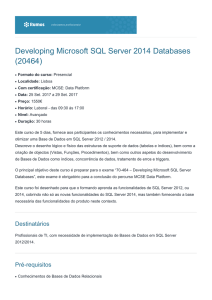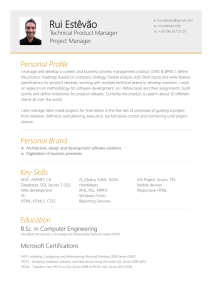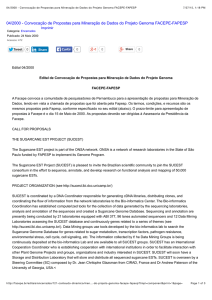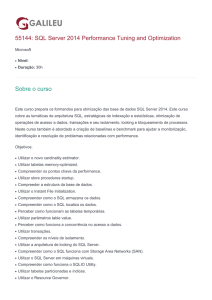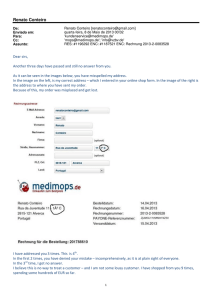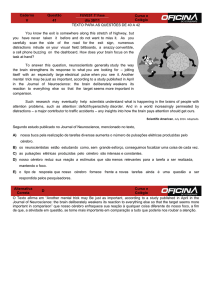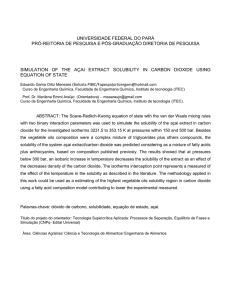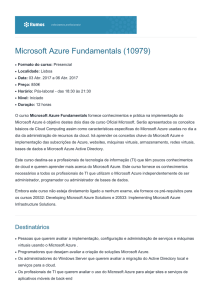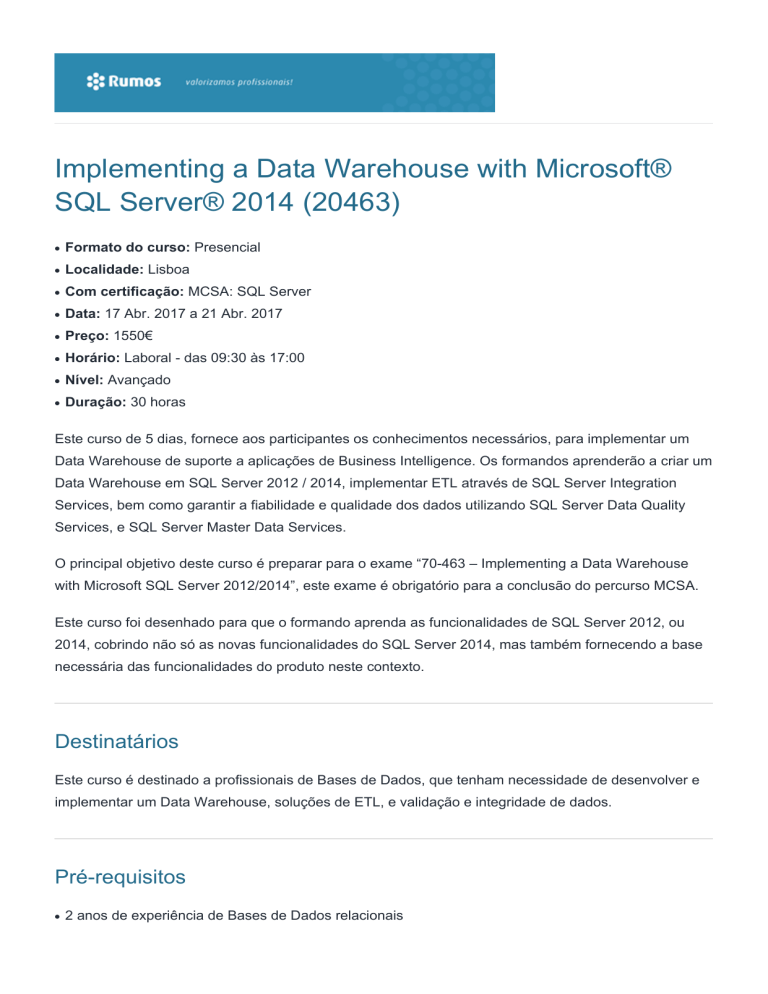
Implementing a Data Warehouse with Microsoft®
SQL Server® 2014 (20463)
●
Formato do curso: Presencial
●
Localidade: Lisboa
●
Com certificação: MCSA: SQL Server
●
Data: 17 Abr. 2017 a 21 Abr. 2017
●
Preço: 1550€
●
Horário: Laboral - das 09:30 às 17:00
●
Nível: Avançado
●
Duração: 30 horas
Este curso de 5 dias, fornece aos participantes os conhecimentos necessários, para implementar um
Data Warehouse de suporte a aplicações de Business Intelligence. Os formandos aprenderão a criar um
Data Warehouse em SQL Server 2012 / 2014, implementar ETL através de SQL Server Integration
Services, bem como garantir a fiabilidade e qualidade dos dados utilizando SQL Server Data Quality
Services, e SQL Server Master Data Services.
O principal objetivo deste curso é preparar para o exame “70-463 – Implementing a Data Warehouse
with Microsoft SQL Server 2012/2014”, este exame é obrigatório para a conclusão do percurso MCSA.
Este curso foi desenhado para que o formando aprenda as funcionalidades de SQL Server 2012, ou
2014, cobrindo não só as novas funcionalidades do SQL Server 2014, mas também fornecendo a base
necessária das funcionalidades do produto neste contexto.
Destinatários
Este curso é destinado a profissionais de Bases de Dados, que tenham necessidade de desenvolver e
implementar um Data Warehouse, soluções de ETL, e validação e integridade de dados.
Pré-requisitos
●
2 anos de experiência de Bases de Dados relacionais
●
Desenho e criação de uma Base de Dados relacional
●
Elaborar Consultas a Bases de Dados SQL Server
●
Algum contacto com alguma ferramenta de desenvolvimento
●
Recomenda-se a frequência dos seguintes cursos:
❍
“20461 – Querying Microsoft SQL Server”,
❍
“20464 – Developing Microsoft SQL Server Databases”
❍
ou conhecimentos equivalentes.
Objectivos
No final da ação de formação os participantes deverão estar aptos a:
●
Descrever os conceitos e arquitetura de um Data Warehouse
●
Escolher uma plataforma de Hardware adequada às necessidades da Solução
●
Desenhar e Implementar um Data Warehouse
●
Implementar Fluxos de Dados em pacotes de SSIS
●
Implementar Controle de Fluxo em pacotes de SSIS
●
Implementar soluções de ETL a suportar extração incremental de dados
●
Implementar soluções de ETL a suportar carregamento incremental de dados
●
Implementar Validação de Dados através de Microsoft Data Quality Services
●
Implementar Master Data Services para reforçar a integridade de dados.
●
Estender as capacidades do SSIS implementando Scripts
●
Configurar e instalar pacotes de SSIS
●
Descrever como uma solução de Business Intelligence pode consumir os dados de um Data
Warehouse
Metodologia
Pode assistir a este curso de forma:
●
Presencial
●
Live Training
●
MOC On-demand
Programa
Introduction to Data Warehousing
This module provides an introduction to the key components of a data warehousing solution and the
high-level considerations you must take into account when you embark on a data warehousing project.
After completing this module, you will be able to:
❍
Describe the key elements of a data warehousing solution
❍
Describe the key considerations for a data warehousing project
Planning Data Warehouse Infrastructure
This module discusses considerations for selecting hardware and distributing SQL Server facilities
across servers. After completing this module, you will be able to:
❍
Describe key considerations for BI infrastructure.
❍
Plan data warehouse infrastructure.
Designing and Implementing a Data Warehouse
This module describes the key considerations for the logical design of a data warehouse, and then
discusses best practices for its physical implementation. After completing this module, you will be able
to:
❍
Describe a process for designing a dimensional model for a data warehouse
❍
Design dimension tables for a data warehouse
❍
Design fact tables for a data warehouse
❍
Design and implement effective physical data structures for a data warehouse
Creating an ETL Solution with SSIS
This module discusses considerations for implementing an ETL process, and then focuses on Microsoft
SQL Server Integration Services (SSIS) as a platform for building ETL solutions. After completing this
module, you will be able to:
❍
Describe the key features of SSIS.
❍
Explore source data for an ETL solution.
❍
Implement a data flow by using SSIS
Implementing Control Flow in an SSIS Package
This module describes how to implement ETL solutions that combine multiple tasks and workflow logic.
After completing this module, you will be able to:
❍
Implement control flow with tasks and precedence constraints
❍
Create dynamic packages that include variables and parameters
❍
Use containers in a package control flow
❍
Enforce consistency with transactions and checkpoints
Debugging and Troubleshooting SSIS Packages
This module describes how you can debug packages to find the cause of errors that occur during
execution. It then discusses the logging functionality built into SSIS that you can use to log events for
troubleshooting purposes. Finally, the module describes common approaches for handling errors in
control flow and data flow. After completing this module, you will be able to:
❍
Debug an SSIS package
❍
Implement logging for an SSIS package
❍
Handle errors in an SSIS package
Implementing a Data Extraction Solution
This module describes the techniques you can use to implement an incremental data warehouse refresh
process. After completing this module, you will be able to:
❍
Plan data extraction
❍
Extract modified data
Loading Data into a Data Warehouse
This module describes the techniques you can use to implement data warehouse load process. After
completing this module, you will be able to:
❍
Describe the considerations for planning data loads
❍
Use SQL Server Integration Services (SSIS) to load new and modified data into a data warehouse
❍
Use Transact-SQL techniques to load data into a data warehouse
Enforcing Data Quality
This module introduces Microsoft SQL Server Data Quality Services (DQS), and describes how you can
use it to cleanse and deduplicate data. After completing this module, you will be able to:
❍
Describe how Data Quality Services can help you manage data quality
❍
Use Data Quality Services to cleanse your data
❍
Use Data Quality Services to match data
Master Data Services
Master Data Services provides a way for organizations to standardize data and improve the quality,
consistency, and reliability of the data that guides key business decisions. This module introduces
Master Data Services and explains the benefits of using it. After completing this module, you will be able
to:
❍
Describe key Master Data Services concepts
❍
Implement a Master Data Services model
❍
Use Master Data Services tools to manage master data
❍
Use Master Data Services tools to create a master data hub
Extending SQL Server Integration Services
This module describes the techniques you can use to extend SSIS. The module is not designed to be a
comprehensive guide to developing custom SSIS solutions, but to provide an awareness of the
fundamental steps required to use custom components and scripts in an ETL process that is based on
SSIS. After completing this module, you will be able to:
❍
Include custom scripts in an SSIS package
❍
Describe how custom components can be used to extend SSIS
Deploying and Configuring SSIS Packages
In this module, students will learn how to deploy packages and their dependencies to a server, and how
to manage and monitor the execution of deployed packages. After completing this module, you will be
able to:
❍
Describe considerations for SSIS deployment.
❍
Deploy SSIS projects.
❍
Plan SSIS package execution.
Consuming Data in a Data Warehouse
This module introduces business intelligence (BI) solutions and describes how you can use a data
warehouse as the basis for enterprise and self-service BI. After completing this module, you will be able
to:
❍
Describe BI and common BI scenarios
❍
Describe how a data warehouse can be used in enterprise BI scenarios
❍
Describe how a data warehouse can be used in self-service BI scenarios

